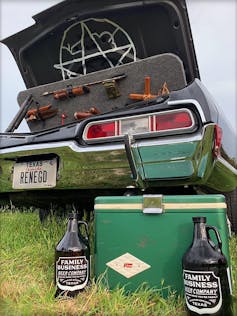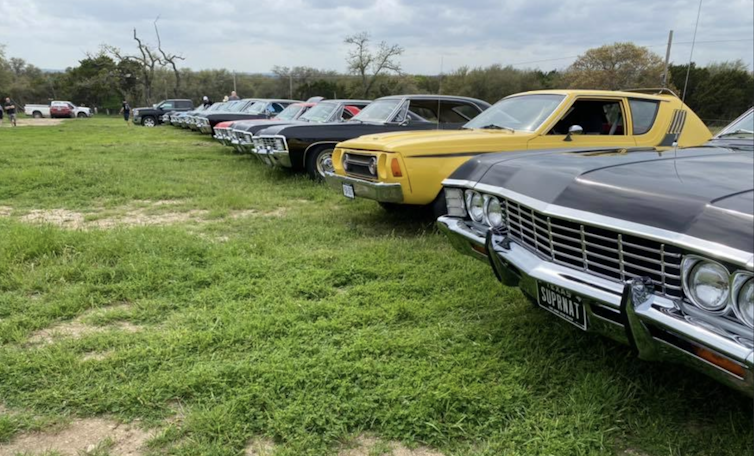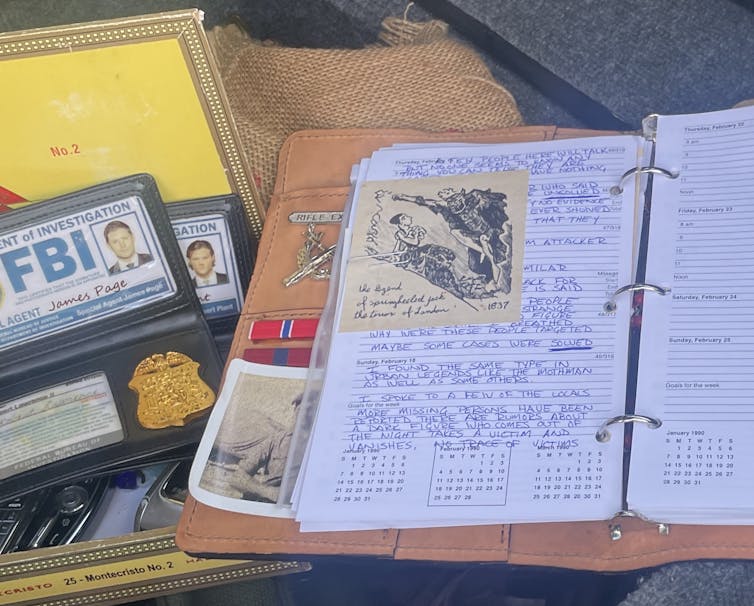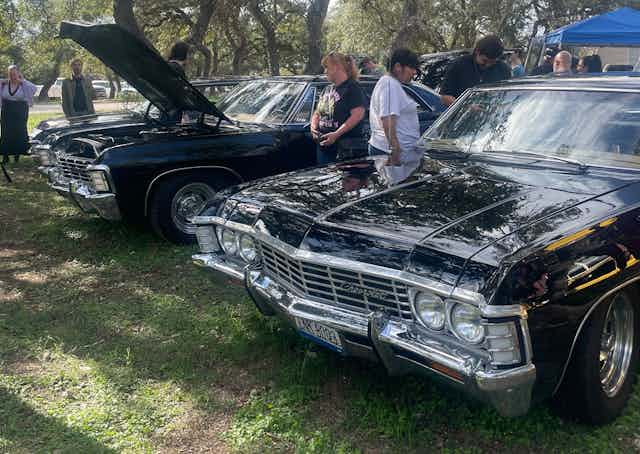Among the many spooky events happening over Halloween weekend was the biannual “Haunting of Impalas” at Family Business Brewing, a 15-acre brewery in Dripping Springs, Texas, owned by actor and musician Jensen Ackles.
Along with Jared Padalecki, Ackles is the star of “Supernatural,” a television series that ran from 2005 to 2020.
A weekly science-fiction show akin to “The X-Files,” “Supernatural” follows two brothers, Sam and Dean Winchester, as they drive in a classic 1967 Chevrolet Impala across the U.S., fighting monsters and uncovering their convoluted family past. Show creator Eric Kripke has described the show as “a modern American Western – two gunslingers who ride into town, fight the bad guys, kiss the girl and ride out into the sunset again.”
With a subtle nod to the show’s tagline: “Saving People, Hunting Things – The Family Business,” Ackles opened the brewery in 2017. It has since become a popular destination for fans of the TV series.
“Supernatural” has been called a “cult” drama, with conventions that draw fans from all over the country. Religious terms like cult are often used to convey how serious the fandom is. But as two scholars of religion, we see the connection between fandom and religion as one that’s stronger and deeper than many people might realize.
If you build it, they will come
The Haunting of Impalas – fans call a gathering of the cars a “haunting” – has been held at the brewery as a free event since 2019, first as a casual meet-up and then as an official event sponsored by the brewery.
As much a character on the show as Ackles and Padalecki themselves, the characters’ black 1967 Impala has become iconic for fans. Elaborating on the debt “Supernatural” owes to Westerns, show writer Kripke said of the Impala, “If you’re going to have cowboys, they need a trusty horse.”

The car serves as the brothers’ home on the road, as their protection from evil and as a repository of monster-hunting weapons. In a nod to the car’s central role, some devoted fans of the show have since bought and restored black 1967 Impalas, which they bring together at the Haunting of Impalas event.
Fans have lovingly recreated each Impala – sometimes even accurate to a specific episode. Lined up, each car reveals a secret trunk compartment filled with weapons from the show, such as vampire-killing machetes, silver bullets for werewolves and holy water for demons.
Further care is taken to reflect other details found in the Impala over the seasons: a small green army man stuck in the ashtray or a partially eaten pie. At the brewery, four Impalas, as well as one AMC Gremlin that appeared in several episodes, were lined up for examination as close to 100 people milled about in the hour we visited. The social media accounts for the brewery registered over 1,500 RSVPs, and one organizer estimated that roughly 1,000 people were in attendance over the course of the day.
‘People just want to have an experience’
In our work, we’ve seen this behavior before. But it’s been in churches and temples rather than the parking lot of a brewery.
Spectators approached the Impalas with a hesitant reverence, eager to touch the trunk or take a photo sitting in the driver’s seat. One Impala received special interest, as it had actually been used in Season 12 of the show – a fact at least a dozen individuals told us in hushed tones. Its owner hovered around the car with a polishing cloth to quickly whisk away any fingerprints left by visiting fans, but was eager to point out each place an actor had signed the car or otherwise left their mark.
Many of the Impalas at the event had been driven across the country for days to participate. Organizer Travis Perdue, a fan in his early 40s, could tick off the whereabouts of other “Supernatural” Impalas – and the owners who had been too sick to come or otherwise detained.

When asked if this event felt spiritual, Perdue explained, “It’s not about the cars; it’s not about the weapons. It’s something else. People just want to have an experience.”
He said that he frequently sees fans getting emotional near the cars. More than a handful of them have burst into tears. He said one person even passed out upon seeing the restored Impala.
We witnessed one man loudly tell his wife, with tears in his eyes, “If I had one of these, I could die happy.”
Sociologist Emile Durkheim has written that when people encounter their community’s sacred symbols, it can overwhelm them – that the feelings these objects inspire act like “material forces that mechanically generate physical effects.”
The Impalas are not the only potent symbols on display at the event, either. Most of the attendees wore some sort of Supernatural-themed apparel – a shirt, a bag or even a tattoo.
Inside several of the cars were facsimiles of the monster-hunting journal written by John Winchester, Sam and Dean’s father in the show. Each journal featured dozens of hand-inked pages, recreations of newspaper articles, a pin for military service in Vietnam and eerie photographs. Like monks producing illuminated manuscripts, a team of fans crafted each journal by hand.
Perdue, who’s worked on the journals, explained that the first facsimile took eight months of research to design, and each subsequent copy took six weeks to produce. They sell them to other fans for $650, and Perdue has a waitlist of dozens of people. But the group makes no money off the journals. Rather, he is motivated by the joy of making such a precious item for other fans.

Fandom as religion or vice versa?
Many scholars have noted the religious aspects of fan culture.
Perhaps, however, we might reverse the comparison and note that religion operates more like a fandom.
Because of America’s Protestant heritage, Americans often assume religion is about beliefs; That’s because Protestantism renounces “salvation through works” in favor of “sola fides,” or “faith alone.”
But most religions don’t work this way. As religion scholar Stephen Prothero points out, “Religions are often called ‘belief systems.’ But the Christian tradition is the only major religion that puts a strong emphasis on beliefs.”
According to Prothero, the common denominator that all religions share is not beliefs but stories. As he puts it, “All religions are ‘story systems.’” Outside of Christianity’s emphasis on creeds, most religious traditions emphasize practices, experiences and stories – exactly the things that drew fans to the Haunting of Impalas.
Pilgrimage – journeying to see sacred places and objects – is found in many religions. In 2023, the Hajj drew about 2 million pilgrims to Mecca despite dangerously high temperatures. Even more common is mimesis, or replicating sacred stories through art and ritual. In the Mexican tradition of Las Posadas, a procession recreates the story of Mary and Joseph being turned away from the inn before smashing a pinata shaped like the star of Bethlehem.
What made “Supernatural” great was not the supernatural. Fans know the Winchester brothers are imaginary. And yet the Winchesters’ story seems to represent something greater than themselves. The Impalas become an object of pilgrimage because they present a physical connection to things that are otherwise intangible and transcendent – a modern mythology and a community of like-minded people.
Religious studies is largely a Western invention, and so it has historically carried a lot of Protestant assumptions, even when discussing non-Christian religions, including the idea that the essence of religions is a set of intellectual propositions about God or the afterlife.
But if scholars of religion shift their analysis from beliefs to stories and communities, who is to say that the world’s religions are not just larger fandoms of figures like Jesus, Buddha or Krishna?

